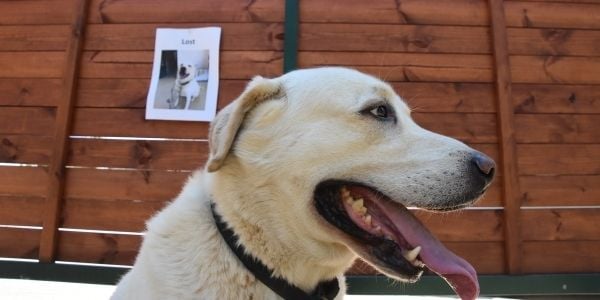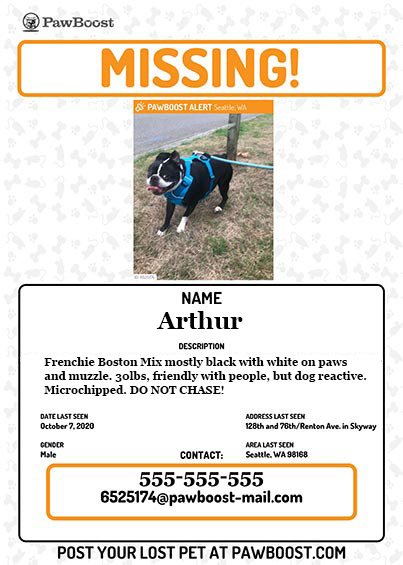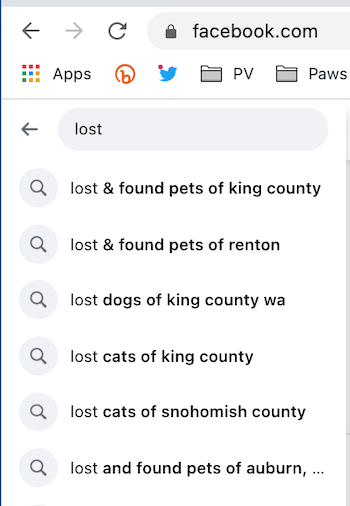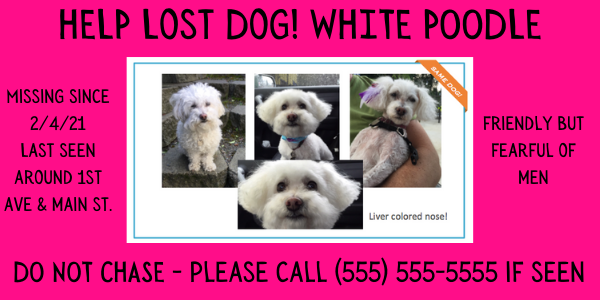 Finding a Lost Dog
Finding a Lost Dog
We are so sorry your dog is missing. We know this is an incredibly stressful time, but it’s important to try not to panic — so please pause for three seconds to take a deep breath, and then follow the steps below.
If possible, recruit friends and family to help divide the responsibilities. Since time is of the essence, we’re going to dive right in.
Skip Ahead
1. Check Your Home First
Check your home and immediate surrounding areas first. This includes, but is not limited to, sheds, garages, cars, swimming pools, and even inside closets. As you do your search, bring some of your dog’s favorite high-value treats or your dog’s favorite toy to coax them out of hiding.
If you cannot find your dog on your property, place some of your dirty clothing and your dog's bedding outside of your home to lure them back through scent.
Now it's time to contact your dog's microchip company, veterinarian, and call the shelters.
2. Call Microchip Company Verify Contact Info
If your dog is microchipped, it is very important to call the microchip company to flag your pup as missing and to ensure that your contact information is up-to-date. If you can’t find your dog’s microchip information, contact your veterinarian’s office or the rescue where you got your dog — there’s a good chance they might have the number on file.
Even if you have your dog's microchip number, let your veterinarian's office know your dog is missing — some clinics will post to their social media accounts on your behalf.
Unfortunately, microchips are useless until they’re registered in a database with your pet’s unique microchip number and your contact information. Even if it hasn't been registered before, if you have your pet's microchip number you can do it right now.
Here is a list of some of the companies you can register your cat's microchip on - they all have different requirements and some may have extra services:
- 24 Pet Watch
- AKC Reunite
- AVID FriendChip
- Free Pet Chip Registry (911PetChip)
- Home Again
- InfoPET
- RESQ
- Petidco (AVIDCanada)
- PetKey
- Pet Link
- Smart Tag
If you have the microchip number but need to search for the microchip manufacturer information, use AAHA’s universal pet microchip lookup tool.
Some microchip companies will also post to social media on your behalf, so look into all options available to you.
Important note: Not every microchip scanner used by shelters and veterinarians covers all the different registries out there. So having your pet’s microchip registered on both the chip manufacturer’s registry and the Found Animals Registry increases the chances that you will have a happy reunion.
If your pet is wearing an electronic ID collar or tag that allows you to update your information, contact them as well to flag your dog as missing and add as much up-to-date information as you can to their profile.
Call local shelters, animal control, and even shelters outside your immediate area, and make sure to check in with them daily. If you aren't sure where to start, do a Google search for animal control in your area. When you speak to them, ask for a list of other shelters you should check with. Facebook will also be helpful for finding this information. (More on that in step 5)
3. Create a Lost Dog Poster
I highly recommend using Pawboost.com (see step 4) to create your lost dog poster because it will save time and be created for you with the information you input to create social media and email alerts they will send on your behalf.
Put up as large of a sign as you can in front of your home or apartment building with your dog's picture and your contact information.
If you'd prefer to make your own poster we've created a Microsoft Word template (includes 3 versions), which you can download and use to create your missing dog posters. Simply replace the placeholder information with your own. Click the image below and the document should download immediately.
4. Get Help From Neighbors and the Internet
Pawboost.com is the website I’ve seen referred to more than any other because it sends its own neighborhood alerts to Facebook and emails everyone who has signed up to be notified about missing pets in your area. This will create a link that you can easily share and include within your other social posts.
Another reason I recommend Pawboost as an early step is that they will turn your lost dog post into easy-to-print fliers for handing out, putting on bulletin boards, and distributing to local retailers, coffee shops, shelters, vet practices, and 24-hour emergency vets. (Please do not put fliers into mailboxes as this is against federal law). Below is an example of the lost dog flier Pawboost creates with your post.

If someone finds your pet, they may also post to Pawboost, so take a little time to look through the posts in your area and immediate surroundings.
Other important places to post include sites like Nextdoor.com and the Ring Neighbors app (you don’t have to have a Ring camera in order to post to the app). This will alert your direct neighbors to keep their eyes out and allow them to contact you directly if there are sightings or if anyone has caught footage of them on their security cameras. In your posts, ask neighbors to also check their own sheds, yards, and garages.
What to Include in Your Lost Dog Posts for Social Media:
- Several different photos including different lighting, full-body shot, close up, at different hair lengths if their coat changes length, color, etc.
- Date and area your dog was lost or last seen along with any information about sightings
- Information about whether your dog may be reactive or fearful to other dogs and/or humans, or whether having another dog out may help aid in the search
- Your contact information, including the best phone numbers to reach you at (and make sure your voicemail boxes aren't full)
- Make sure to include "DO NOT CHASE" and instruct them not to call out to your dog as this generally makes dogs run further in the opposite direction. If possible, refer them to this video on using calming signals to get your dog to come to them safely.
- A link to your Pawboost alert
How to Use Calming Signals with an Anxious Dog
5. Use Facebook
While social media definitely has its challenges, it can be incredibly helpful when trying to reunite with your lost dog. If you aren’t on Facebook, ask someone you know to post on your behalf. If you are on Facebook, log in and do a search for both lost dog and lost pet groups for your county, your city, and even your specific neighborhood. Use the guidelines from step 4 for creating your Facebook group posts.
 There are a lot of people who will be happy to help in your search. How am I so sure? The screenshot to the left is only a partial list of groups I belong to on Facebook, specifically to help people in my area whose pets have gone missing. In my experience, the other members of those groups will cross-post to other groups you may not have access to, such as private community groups, and also be able to provide advice specifically geared towards your area, including the local shelters, vet clinics, and 24 hr emergency vets to contact to alert to your situation. Some may even offer to help search for your precious pup or lend a humane trap.
There are a lot of people who will be happy to help in your search. How am I so sure? The screenshot to the left is only a partial list of groups I belong to on Facebook, specifically to help people in my area whose pets have gone missing. In my experience, the other members of those groups will cross-post to other groups you may not have access to, such as private community groups, and also be able to provide advice specifically geared towards your area, including the local shelters, vet clinics, and 24 hr emergency vets to contact to alert to your situation. Some may even offer to help search for your precious pup or lend a humane trap.
I am fortunate enough to live in an area where one of the lost dog Facebook groups I belong to is moderated by an incredibly knowledgeable man who owns a tracking and retrieving business devoted to recovering lost animals and strays. He offers great advice but also has been instrumental at locating and trapping lost dogs and cats when called upon for his services. If you feel your situation warrants it, don’t hesitate to find a reputable person in your area who provides similar services.
Look through existing posts to see if anyone has posted sightings or other helpful information about your dog’s whereabouts. One of the biggest benefits to posting to these Facebook groups is that it expands the search in all different directions very quickly and can be easily shared by friends, family, and strangers.
6. Other Helpful Resources and Websites
Other missing animal sites to post to:
- PetFBI
- Finding Rover
- LostMyDoggie
- Craigslist
Missing Animal Response Network has a treasure trove of information as well as a directory of people in your state who have been through their training program to help you find your lost pet. They also provide information on:
- Lost Dog Behavior
- Important information about why you shouldn’t call out your dog’s name when searching
- Great tips on creating large neon signs that are easy to read and guaranteed to draw attention
- Helpful information regarding whether or not to offer a reward (spoiler alert: it is no longer recommended due to the crazy world we live in where people take advantage of others going through terrible situations)
7. Large Neon Signs
Creating large neon signs takes time (which is why it is step 7) but since not everyone is on social media and not everyone speaks the same language, it is absolutely one of the best ways to find your missing dog.

While social media is great for getting into details, large neon signs can be thought of as more of a highway billboard. You want to attract attention but need to get the message across as quickly as possible for drivers to be able to understand and help.
Include a clear photo of your dog with "LOST DOG - DO NOT CHASE" and your phone number or email address in large print.
You’ll want to make sure these are weather-proofed in case of bad weather; if possible use sheet protectors or have them laminated. For more details about the importance of making these posters, you'll find more tips at Missing Animal Response Network.
Beware of Lost Dog Scams
Unfortunately, there are crooks who have decided to take advantage of people during times of distress. Be very careful when dealing with people contacting you about your pet and please take extra steps to protect yourself. When meeting up with a potential finder if possible meet in a public space and have someone come with you.
To keep yourself from becoming a victim or being distracted from the search for your dog, consider ways of verifying that someone really has your dog before proceeding. For instance, are there any unique features that aren’t visible in your “Lost Dog” poster? Ask the person to send a photo of your dog — this should be an easy request to fulfill thanks to smartphones. Heck, even flip phones have the capability to take a picture and send via text.
Do not click links from strangers claiming they need you to verify something — this is a new scam I've seen lately and there is absolutely no reason anyone needs you to do this in order for you to get information about your missing pet.
In general, be wary of someone who demands reward money upfront and don’t agree to wire someone money before getting your dog from them. The following are some common scams, as originally detailed by PetAmberAlert:
Beware of Up-Front Payment
A scammer might try to convince you that they have your dog but will only return it after you pay them. Some might even threaten to harm your dog if you don’t pay.
Beware of Truck Drivers
Another scam might take the form of a “truck driver” who claims they saw your dog on their route. The purported driver will demand money before they will agree to “drive back” and pick up your dog.
Beware of Out-of-State Calls
Scammers sometimes claim that your dog wandered across the state border. They will agree to send you back your dog, but demand that you pay for a flight, kennel, or other costly means of returning your dog.
Reunited and It Feels So Good
Even after you have successfully reunited with your pooch, there are still a few more steps to take.
Clean Up
Circle back around and remove all of the “Lost Dog” posters you hung up, and update any notices you put up online. Not only will it help your friends, family, and neighbors celebrate the return of your pet, but it’ll also prevent people from continuing an unnecessary search, and will free up space for the next animal in need of finding.
Schedule a Vet Check-up
It’s a good idea to bring your found dog to your veterinarian for a check-up. Depending on their situation — how long they were gone, where they went, where they were found, etc. — your dog may have injuries (potentially internal ones that you can't see), eaten something they shouldn’t have, picked up nasty parasites, or be dealing with a host of other problems. A quick trip to the vet can help put your mind at ease that all is well and, if there’s a problem, catch it early.
Have any tips of your own? Ever found a lost dog? Share your experience with our community!



